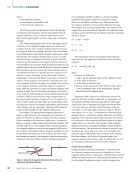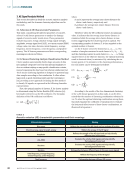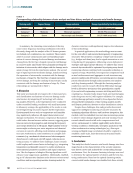axial and radial magnetic leakage field, and to obtain the rela-
tionship between the edge angle of discontinuities of differ-
ent shapes and the changes in magnetic leakage signals. To
simplify the calculation, a steel plate is used as the test sample,
with artificial defects machined on its surface to simulate real
conditions, as shown in Figure 2. The model includes a mild
steel sample, an excitation coil, a soft iron yoke, a Hall element,
and an artificial defect. The material properties of each part are
listed in Table 1.
In particular, when grid dissection is performed using
COMSOL software, focused calculations and grid encryption
are applied near the surface on the defect side to improve
the smoothness and accuracy of the leakage field acquisition
results.
Magnetic Leakage Signal Analysis of Discontinuities
with Different Edge Angles
In engineering, the edge angles of discontinuities can vary
arbitrarily between 0° and 180°. This paper focuses on the
study of discontinuity edge angles in the range of 0° to 90°, as
these angles are more common in actual working conditions.
Based on the principle of magnetic leakage detection and
COMSOL simulation, this paper presents several discontinuity
models and further investigates the characteristic relationship
between the edge angles of these discontinuity models and the
magnetic leakage signal.
Selection of Liftoff Values in Leakage Detection
The choice of liftoff value is one of the key factors affecting
the acquisition of a magnetic leakage signal. A suitable liftoff
value should be selected based on the actual detection of the
component. If the liftoff value is too small, friction may occur
with the sensor during the moving detection process, thus
shortening the service life of the sensor. Similarly, if the liftoff
value is too large, the signal collected by the sensor will be
weak and the sensor may not be sensitive to magnetic leakage
signals. Therefore, a right-angled trapezoidal discontinuity with
an edge angle of 63° is taken as the object of study, with liftoff
values of 0.2 mm, 0.5 mm, 0.7 mm, and 1 mm set. The results
of the simulated signals are shown in Figure 3.
From Figures 3a and 3b, it can be seen that the intensity
of the magnetic leakage signal decreases as the liftoff value
increases. The radial and axial magnetic leakage signals are
strongest when the liftoff value is 0.2 mm. Practical consid-
erations for the experimental process suggest using a higher
liftoff value to better protect the sensors from damage (Sun
and Kang 2010). This paper chooses a liftoff value of 0.5 mm
for the subsequent study.
Artificial
defect
Hall element
Soft iron yoke
Excitation coil
Low-carbon steel
Figure 2. Leakage detection simulation model.
TA B L E 1
Material properties of the components
Part Material Relative
permeability
Conductivity
(S/m)
Sample Carbon steel 400 8.41 107
Excitation coil Copper 1 5.99 107
Yoke Soft iron 4000 1.12 107
80
70
60
50
40
40
50
60
70
80
90
100
110
120
30
30
20
10
–10
–20
–30
–40
–50
–60
–70
–80
–90
–100
0
0 5 10
Scanning path (mm) Scanning path (mm)
15 20 0 5 10 15 20
0.2 mm
0.5 mm
0.7 mm
1 mm
0.2 mm
0.5 mm
0.7 mm
1 mm
Figure 3. Distribution of radial and axial signals of magnetic leakage for different liftoff values: (a) radial signal component (b) axial signal
component.
M AY 2 0 2 5 • M AT E R I A L S E V A L U AT I O N 33
B
(mT)
B
(mT)
tionship between the edge angle of discontinuities of differ-
ent shapes and the changes in magnetic leakage signals. To
simplify the calculation, a steel plate is used as the test sample,
with artificial defects machined on its surface to simulate real
conditions, as shown in Figure 2. The model includes a mild
steel sample, an excitation coil, a soft iron yoke, a Hall element,
and an artificial defect. The material properties of each part are
listed in Table 1.
In particular, when grid dissection is performed using
COMSOL software, focused calculations and grid encryption
are applied near the surface on the defect side to improve
the smoothness and accuracy of the leakage field acquisition
results.
Magnetic Leakage Signal Analysis of Discontinuities
with Different Edge Angles
In engineering, the edge angles of discontinuities can vary
arbitrarily between 0° and 180°. This paper focuses on the
study of discontinuity edge angles in the range of 0° to 90°, as
these angles are more common in actual working conditions.
Based on the principle of magnetic leakage detection and
COMSOL simulation, this paper presents several discontinuity
models and further investigates the characteristic relationship
between the edge angles of these discontinuity models and the
magnetic leakage signal.
Selection of Liftoff Values in Leakage Detection
The choice of liftoff value is one of the key factors affecting
the acquisition of a magnetic leakage signal. A suitable liftoff
value should be selected based on the actual detection of the
component. If the liftoff value is too small, friction may occur
with the sensor during the moving detection process, thus
shortening the service life of the sensor. Similarly, if the liftoff
value is too large, the signal collected by the sensor will be
weak and the sensor may not be sensitive to magnetic leakage
signals. Therefore, a right-angled trapezoidal discontinuity with
an edge angle of 63° is taken as the object of study, with liftoff
values of 0.2 mm, 0.5 mm, 0.7 mm, and 1 mm set. The results
of the simulated signals are shown in Figure 3.
From Figures 3a and 3b, it can be seen that the intensity
of the magnetic leakage signal decreases as the liftoff value
increases. The radial and axial magnetic leakage signals are
strongest when the liftoff value is 0.2 mm. Practical consid-
erations for the experimental process suggest using a higher
liftoff value to better protect the sensors from damage (Sun
and Kang 2010). This paper chooses a liftoff value of 0.5 mm
for the subsequent study.
Artificial
defect
Hall element
Soft iron yoke
Excitation coil
Low-carbon steel
Figure 2. Leakage detection simulation model.
TA B L E 1
Material properties of the components
Part Material Relative
permeability
Conductivity
(S/m)
Sample Carbon steel 400 8.41 107
Excitation coil Copper 1 5.99 107
Yoke Soft iron 4000 1.12 107
80
70
60
50
40
40
50
60
70
80
90
100
110
120
30
30
20
10
–10
–20
–30
–40
–50
–60
–70
–80
–90
–100
0
0 5 10
Scanning path (mm) Scanning path (mm)
15 20 0 5 10 15 20
0.2 mm
0.5 mm
0.7 mm
1 mm
0.2 mm
0.5 mm
0.7 mm
1 mm
Figure 3. Distribution of radial and axial signals of magnetic leakage for different liftoff values: (a) radial signal component (b) axial signal
component.
M AY 2 0 2 5 • M AT E R I A L S E V A L U AT I O N 33
B
(mT)
B
(mT)













































































